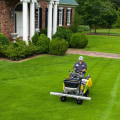Tackle these 15-minute yard maintenance projects now, and then you can rest easy once the temperature drops. In late fall, drop the mower and cut the lawn 1 to 2 inches shorter than the rest of the growing season. Continue mowing the shortest lawn until the grass stops growing in early winter, when both you and your lawn go into hibernation mode. For the final cut, lower it a little lower.
Among lawn care experts, it is a well-known fact that the best way to ensure a thick, green and healthy lawn in the spring is to take care of it on time in the fall, in other words, right now. But according to Scott Frith, CEO of Lawn Doctor, a lawn care company with more than 200 franchises across the country, many homeowners make the same basic mistakes before the lawn goes idle, and then wonder why their lawn isn't doing better the following year. This is Frith's seven-step program to get a beautiful lawn next year. Don't put the lawnmower away yet.
The grass continues to grow until the first hard frost, so you will need regular cuttings to keep it at an ideal height of 2 ½ to 3 inches. If you let it get too long, it will become clogged and vulnerable to fungi such as snow mold. This is why Frith recommends the late autumn application of a slow-release granular fertilizer 24-0-10. The numbers indicate the weight percent of nitrogen, phosphorus and potassium, respectively. Potassium is also important at this time because it helps root growth, disease protection, drought tolerance and cold resistance.
A soil test can tell you how much of each nutrient your lawn actually needs. Lawn Doctor's company policy is to maintain a 5-foot shock absorber where water is present. Autumn is the best time to fertilize your lawn if you live in the north. Cold-season grasses, such as bluegrass, fescue and rootgrass, respond well to feeding in early September and again in late autumn (late October or November).
It helps them to turn green sooner and look better in spring. The lawn still needs water in the fall, even though the leaves are changing, the growing season is declining and the grass doesn't grow as fast. Watering in autumn helps the lawn recover from summer stress and gain strength for the coming winter. In addition, if fertilized in autumn, watering is necessary so that the fertilizer dissolves and soaks into the soil where it is needed.
So don't put away hoses or sprinklers until the ground starts to freeze, as the autumn lawn still needs water. Many people think that there is not much to do to care for the lawn in the fall season because the grass stops growing so much. Whether you're just starting out, servicing or troubleshooting, you'll find tips and answers for all your lawn care needs here. If following the schedule during the fall is proving too difficult, a lawn care service can take care of the jobs that are not being done.
If you must use a herbicide, follow all directions on the label carefully and target only the weeds you want to kill rather than treat the entire lawn. You can take advantage of spring and help raise your neighborhood's lawn care bar a little bit for next year.






